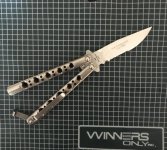This thread is meant to be about knives we have inherited from our fathers. But if you aren’t fortunate enough to own a knife of your father’s, feel free to post about a knife that has sentimental or historical value to you for other reasons.
And, as always, comments from well informed members, in this case on the knife I am posting about, are always welcome.
My father carried this knife, a Cattaraugus 225Q, in the Pacific in WWII as a Marine 2nd lieutenant and interpreter of Japanese. He fought in the great battles of Peleliu and Okinawa.

I recall him carrying it in the 1950s in northern Virginia, near what is now Dulles Airport, when we were out and about in the woods. His using it to chop through grape vines, or so we called them, to keep them from strangling trees in particular has stayed with me.
I was maybe four or five. I learned the word “groove” from this knife when I asked my dad what the trough-like indentation in the blade was.
Growing up, as I began to acquire knives of my own, I always compared them to my dad’s “combat knife,” as we called the Cattaraugus, and my acquisitions always seemed to come up short. (Like most boys of my generation, I was allowed to have a knife from, insofar as I can remember, when I first realized I wanted one. My first was a cheap, extremely dull, paring knife with a red plastic handle. I recall having that with me when out in the woods with my dad and his knife. (Never did learn how to sharpen it, though not for lack of trying.)
My father passed on in 1995. At home and in bed. With his wife and children all gathered around him. I was able to make it home from Japan in time for his death. He had taken the knife out of his dresser drawer and put it beside him on his nightstand. I think the drugs he was taking for his cancer gave him bad dreams, and having his trusty knife within reach gave him a measure of comfort.
After he passed on, the knife came to me. It was pretty rusty at that point, so I spent some time cleaning it up with fine grit sandpaper and WD40. I also had a nice custom sheath made for it as at the time my dad’s old sheath, falling apart, seemed a bit too shabby for it.


Now, over 23 years later, I am considering trying to restore the sheath. I think my father made it from a kit shortly after the war. (A leather sheath this flimsy seems unlikely to have been carried in the Pacific.

Still, interesting that it is left handed, since my father was right handed. In the war he carried his pistol on his right, so, like many, he preferred, I assume, his knife on his left. I guess he grew accustomed to having his knife on his left, and just continued with the practice after the war.)
While the old sheath seems to be made from a kit, I think my mother may have helped him with the animal designs. (She was artistic — my dad decidedly was not!)

And I do recall when I mentioned to my mother — she, too, is now long gone— that I had had a new, custom sheath made, that she gave me a swift look of disapproval, though she said nothing. At the time her look perplexed me, but now I think it likely because she recalled my father, perhaps with her participation, making the sheath. They lived in Colorado then.
If I do restore the sheath, I am thinking to glue some sort of tough but thin backing to the front, animal-decorated panel, and then the same to the interior facing side of the back of the sheath pocket and then continuing up and behind the belt loop so that the non visible part of the sheath, the old leather, is completely supported. Then lace/sew the sheath back together.
We’ll see if I get around to it.
So, how about you? Any other sons out there who own and treasure their father’s knife?
And, as always, comments from well informed members, in this case on the knife I am posting about, are always welcome.
My father carried this knife, a Cattaraugus 225Q, in the Pacific in WWII as a Marine 2nd lieutenant and interpreter of Japanese. He fought in the great battles of Peleliu and Okinawa.

I recall him carrying it in the 1950s in northern Virginia, near what is now Dulles Airport, when we were out and about in the woods. His using it to chop through grape vines, or so we called them, to keep them from strangling trees in particular has stayed with me.
I was maybe four or five. I learned the word “groove” from this knife when I asked my dad what the trough-like indentation in the blade was.
Growing up, as I began to acquire knives of my own, I always compared them to my dad’s “combat knife,” as we called the Cattaraugus, and my acquisitions always seemed to come up short. (Like most boys of my generation, I was allowed to have a knife from, insofar as I can remember, when I first realized I wanted one. My first was a cheap, extremely dull, paring knife with a red plastic handle. I recall having that with me when out in the woods with my dad and his knife. (Never did learn how to sharpen it, though not for lack of trying.)
My father passed on in 1995. At home and in bed. With his wife and children all gathered around him. I was able to make it home from Japan in time for his death. He had taken the knife out of his dresser drawer and put it beside him on his nightstand. I think the drugs he was taking for his cancer gave him bad dreams, and having his trusty knife within reach gave him a measure of comfort.
After he passed on, the knife came to me. It was pretty rusty at that point, so I spent some time cleaning it up with fine grit sandpaper and WD40. I also had a nice custom sheath made for it as at the time my dad’s old sheath, falling apart, seemed a bit too shabby for it.


Now, over 23 years later, I am considering trying to restore the sheath. I think my father made it from a kit shortly after the war. (A leather sheath this flimsy seems unlikely to have been carried in the Pacific.

Still, interesting that it is left handed, since my father was right handed. In the war he carried his pistol on his right, so, like many, he preferred, I assume, his knife on his left. I guess he grew accustomed to having his knife on his left, and just continued with the practice after the war.)
While the old sheath seems to be made from a kit, I think my mother may have helped him with the animal designs. (She was artistic — my dad decidedly was not!)

And I do recall when I mentioned to my mother — she, too, is now long gone— that I had had a new, custom sheath made, that she gave me a swift look of disapproval, though she said nothing. At the time her look perplexed me, but now I think it likely because she recalled my father, perhaps with her participation, making the sheath. They lived in Colorado then.
If I do restore the sheath, I am thinking to glue some sort of tough but thin backing to the front, animal-decorated panel, and then the same to the interior facing side of the back of the sheath pocket and then continuing up and behind the belt loop so that the non visible part of the sheath, the old leather, is completely supported. Then lace/sew the sheath back together.
We’ll see if I get around to it.
So, how about you? Any other sons out there who own and treasure their father’s knife?




